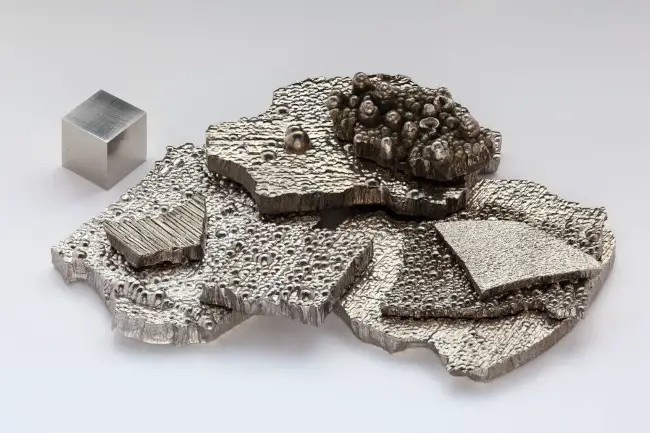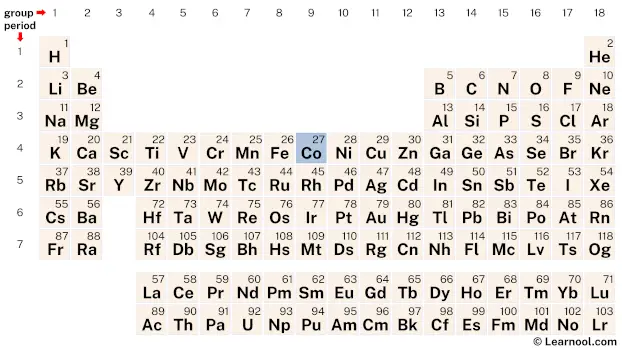
Cobalt (Co) is a chemical element of the periodic table, located in the group 9 and the period 4, and is having the atomic number 27. It is a hard, lustrous, silvery-grey transition metal, whose name comes from the German word “kobald”, which means goblin.
On periodic table
| group | ⇨ | 1 | 2 | 3 | 4 | 5 | 6 | 7 | 8 | 9 | 10 | 11 | 12 | 13 | 14 | 15 | 16 | 17 | 18 |
| period | ⇩ | ||||||||||||||||||
| 1 | 1 H  Hydrogen |
2 He  Helium |
|||||||||||||||||
| 2 | 3 Li  Lithium |
4 Be  Beryllium |
5 B  Boron |
6 C  Carbon |
7 N  Nitrogen |
8 O  Oxygen |
9 F  Fluorine |
10 Ne  Neon |
|||||||||||
| 3 | 11 Na  Sodium |
12 Mg  Magnesium |
13 Al  Aluminium |
14 Si Silicon |
15 P  Phosphorus |
16 S  Sulfur |
17 Cl  Chlorine |
18 Ar  Argon |
|||||||||||
| 4 | 19 K  Potassium |
20 Ca  Calcium |
21 Sc  Scandium |
22 Ti  Titanium |
23 V  Vanadium |
24 Cr  Chromium |
25 Mn  Manganese |
26 Fe  Iron |
27 Co Cobalt |
28 Ni  Nickel |
29 Cu  Copper |
30 Zn  Zinc |
31 Ga  Gallium |
32 Ge  Germanium |
33 As  Arsenic |
34 Se  Selenium |
35 Br  Bromine |
36 Kr  Krypton |
|
| 5 | 37 Rb  Rubidium |
38 Sr  Strontium |
39 Y  Yttrium |
40 Zr  Zirconium |
41 Nb  Niobium |
42 Mo  Molybdenum |
43 Tc  Technetium |
44 Ru  Ruthenium |
45 Rh  Rhodium |
46 Pd  Palladium |
47 Ag  Silver |
48 Cd  Cadmium |
49 In  Indium |
50 Sn  Tin |
51 Sb  Antimony |
52 Te  Tellurium |
53 I  Iodine |
54 Xe  Xenon |
|
| 6 | 55 Cs  Caesium |
56 Ba  Barium |
72 Hf  Hafnium |
73 Ta  Tantalum |
74 W  Tungsten |
75 Re  Rhenium |
76 Os  Osmium |
77 Ir  Iridium |
78 Pt  Platinum |
79 Au  Gold |
80 Hg  Mercury |
81 Tl  Thallium |
82 Pb  Lead |
83 Bi  Bismuth |
84 Po  Polonium |
85 At  Astatine |
86 Rn  Radon |
||
| 7 | 87 Fr  Francium |
88 Ra  Radium |
104 Rf  Rutherfordium |
105 Db  Dubnium |
106 Sg  Seaborgium |
107 Bh  Bohrium |
108 Hs  Hassium |
109 Mt  Meitnerium |
110 Ds  Darmstadtium |
111 Rg  Roentgenium |
112 Cn  Copernicium |
113 Nh  Nihonium |
114 Fl  Flerovium |
115 Mc  Moscovium |
116 Lv  Livermorium |
117 Ts  Tennessine |
118 Og  Oganesson |
||
| 57 La  Lanthanum |
58 Ce  Cerium |
59 Pr  Praseodymium |
60 Nd  Neodymium |
61 Pm  Promethium |
62 Sm  Samarium |
63 Eu  Europium |
64 Gd  Gadolinium |
65 Tb  Terbium |
66 Dy  Dysprosium |
67 Ho  Holmium |
68 Er  Erbium |
69 Tm  Thulium |
70 Yb  Ytterbium |
71 Lu  Lutetium |
|||||
| 89 Ac  Actinium |
90 Th  Thorium |
91 Pa  Protactinium |
92 U  Uranium |
93 Np  Neptunium |
94 Pu  Plutonium |
95 Am  Americium |
96 Cm  Curium |
97 Bk  Berkelium |
98 Cf  Californium |
99 Es  Einsteinium |
100 Fm  Fermium |
101 Md  Mendelevium |
102 No  Nobelium |
103 Lr  Lawrencium |
|||||
| – d block |
Cobalt is a d-block element, situated in the ninth column and the fourth row of the periodic table, denoted by the atomic number 27 and chemical symbol Co.
Element information
 |
|
 |
|
| Origin of name | German word “kobald” (which means goblin) |
| Symbol | Co |
| Atomic number (Z) | 27 |
| Atomic mass | 58.933195 u |
| Block | d-block |
| Group | 9 |
| Period | 4 |
| Classification | Transition metal |
| Atomic radius | 125 pm |
| Covalent radius | Low spin: 126±3 pm High spin: 150±7 pm |
| Melting point | 1495 ℃, 2723 ℉, 1768 K |
| Boiling point | 2927 ℃, 5301 ℉, 3200 K |
| Electron configuration | [Ar] 3d7 4s2 |
| Electrons per shell | 2, 8, 15, 2 |
| Learn how to draw: Cobalt Bohr model | |
| Crystal structure | Hexagonal close-packed (hcp) |
| Phase at r.t | Solid |
| Density near r.t | 8.90 g/cm3 |
| Main isotopes | Cobalt-59 |
| Natural occurrence | Primordial |
| Oxidation state | +2, +3 |
| Electronegativity (Pauling scale) | 1.88 |
| Protons Neutrons Electrons |
27 32 27 |
| Learn how to find: Cobalt protons neutrons electrons | |
| CAS number | 7440-48-4 |
| Discovered by | Georg Brandt in 1735 |
History
Cobalt was first discovered in 1735 by the Swedish chemist Georg Brandt. Brandt was studying the properties of the mineral “smalt,” which was used as a blue pigment in glass and ceramics.
He discovered that smalt contained a new element, which he named “cobalt” after the German word “kobold,” which means “goblin” or “evil spirit.” This name was given to cobalt because it was often found with arsenic, which was known to be poisonous.
After its discovery, cobalt was primarily used as a blue pigment in glass and ceramics. The use of cobalt in alloys was not discovered until the 18th century when it was found that adding cobalt to steel increased its strength and toughness.
This led to the development of cobalt-based alloys, which are still used today in a wide range of applications, from aircraft engines to dental implants.
Occurrence and production
Cobalt is a relatively rare element that is typically found in association with other metals, particularly nickel and copper. The most important ores of cobalt are cobaltite (CoAsS) and erythrite [Co3(AsO4)2 · 8H2O], but it can also be found in other minerals such as pentlandite and pyrite.
The majority of the world’s cobalt is mined in the Democratic Republic of Congo (DRC), which is responsible for about 70% of global production. Other significant producers of cobalt include Russia, Australia, and Canada.
Cobalt production typically involves mining and processing the ores to extract the metal. In the DRC, much of the cobalt is mined by artisanal miners, who work with rudimentary tools and often use child labor. This has led to growing concerns over the ethical and environmental impacts of cobalt mining.
Once the cobalt is extracted from the ore, it can be refined through a variety of processes, including roasting, leaching, and electrolysis. The resulting cobalt can be used in a wide range of applications, including batteries, magnets, and alloys.
The increasing demand for cobalt in industries such as electric vehicles and renewable energy has led to efforts to increase the efficiency and sustainability of cobalt production, as well as to reduce the environmental and social impacts of mining.
Properties
Cobalt is a hard, lustrous, silver-gray metal that belongs to the transition metal group of elements.
It has a melting point of 1495 ℃ and a boiling point of 2927 ℃.
Cobalt has a density of 8.90 grams per cubic centimeter, which is similar to that of iron and nickel.
It is a ferromagnetic metal, which means that it is strongly attracted to magnets.
Cobalt has a high magnetic permeability, which makes it useful in the production of magnetic alloys and magnets.
It is relatively resistant to corrosion and oxidation, which makes it useful in a variety of industrial applications.
Cobalt can form a variety of compounds, including cobalt oxide, cobalt chloride, and cobalt sulfate.
It is an essential trace element in the human diet, playing a role in the production of red blood cells.
Cobalt has been found to have some toxic effects, particularly in high doses, and is classified as a possible human carcinogen by the International Agency for Research on Cancer.
Applications
Alloys
Cobalt is commonly used as an alloying element in the production of high-strength and corrosion-resistant alloys.
It is often alloyed with other metals such as nickel, chromium, and tungsten to create alloys with unique properties. For example, cobalt-chromium alloys are commonly used in dental implants and prosthetics due to their biocompatibility and corrosion resistance.
Batteries
Cobalt is an essential component of lithium-ion batteries, which are used in a variety of electronic devices such as smartphones, laptops, and electric vehicles. The high energy density and long cycle life of these batteries are due in part to the use of cobalt-containing cathodes.
Catalysts
Cobalt compounds are used as catalysts in a variety of industrial processes. For example, cobalt oxide is used as a catalyst in the production of ammonia, while cobalt-containing catalysts are used in the petroleum refining industry to remove sulfur and other impurities from fuels.
Pigments
Cobalt is used as a pigment in the production of blue and green ceramics, glass, and paints. Cobalt blue, one of the most famous pigments, has been used since ancient times.
Magnetic materials
Cobalt is a ferromagnetic metal and is used in the production of magnetic alloys and magnets. These materials are used in a variety of applications, including electric motors, generators, and magnetic data storage devices.
Medical applications
Cobalt is used in medical applications, such as in radiation therapy for cancer treatment and as a tracer in medical imaging studies.
Interesting facts
The name cobalt comes from the German word “kobold,” meaning “goblin” or “evil spirit,” as miners in the Middle Ages believed cobalt ore was poisonous and was the work of these supernatural creatures.
Cobalt is the first element to be discovered solely through the use of spectroscopy. Swedish chemist Georg Brandt identified cobalt in 1735 by examining its unique spectral lines.
Cobalt is a rare element and makes up only about 0.0029% of the Earth’s crust.
The blue color of the pigment cobalt blue is due to the presence of cobalt ions in the chemical compound cobalt aluminate.
Cobalt has a high melting point of 1495 ℃ (2723 ℉) and is one of the few elements that is ferromagnetic at room temperature.
The use of cobalt-60, a radioactive isotope of cobalt, in radiation therapy has saved countless lives in the treatment of cancer.
In the 1930s, a team of researchers at General Motors discovered that adding small amounts of cobalt to tungsten carbide created an extremely hard and wear-resistant material that would revolutionize the cutting tool industry.
Cobalt is an essential component of the vitamin B12 molecule, which is necessary for the formation of red blood cells and the proper functioning of the nervous system.
Cobalt is used in the production of blue glass, which was used in ancient civilizations such as Egypt and Persia.
The largest producer of cobalt is the Democratic Republic of Congo, which supplies about 60% of the world’s cobalt. However, the mining and production of cobalt in this region has been criticized for ethical and environmental concerns.
Related
More elements
External links
- https://www.rsc.org/periodic-table/element/27/cobalt
- https://www.britannica.com/science/cobalt-chemical-element
- https://en.wikipedia.org/wiki/Cobalt
- https://pubchem.ncbi.nlm.nih.gov/element/Cobalt
- https://www.chemicool.com/elements/cobalt.html
- https://www.livescience.com/29275-cobalt.html
- https://www.ducksters.com/science/chemistry/cobalt.php
Deep
Learnool.com was founded by Deep Rana, who is a mechanical engineer by profession and a blogger by passion. He has a good conceptual knowledge on different educational topics and he provides the same on this website. He loves to learn something new everyday and believes that the best utilization of free time is developing a new skill.
